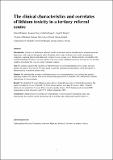| dc.contributor.author | Ganter, Niamh M. | |
| dc.contributor.author | Tong, Kezanne | |
| dc.contributor.author | McDonald, Colm | |
| dc.contributor.author | Doherty, Anne M. | |
| dc.date.accessioned | 2019-09-05T10:55:59Z | |
| dc.date.issued | 2019-01-10 | |
| dc.identifier.citation | Ganter, Niamh M., Tong, Kezanne, McDonald, Colm, & Doherty, Anne M. (2019). The clinical characteristics and correlates of lithium toxicity in a tertiary referral centre. Irish Journal of Medical Science, 188(3), 1103-1109. doi: 10.1007/s11845-018-01963-9 | en_IE |
| dc.identifier.issn | 0021-1265 | |
| dc.identifier.issn | 1863-4362 | |
| dc.identifier.uri | http://hdl.handle.net/10379/15402 | |
| dc.description.abstract | Introduction Lithium is a medication indicated for the treatment of bipolar disorder and treatment-resistant depression, with a narrow therapeutic index. Overdose, either acute or chronic can result in neurological symptoms, requiring dialysis and admission to intensive care in some cases. Lithium toxicity is avoidable with careful monitoring. However, we have noted several recent cases of lithium toxicity in our local service and thus sought to investigate this issue in a more systematic manner.Aim We aimed to quantify the incidence of lithium toxicity in our local population over a single year and identify the patients most at risk. We also aimed to generate clinical recommendations on the prevention of lithium toxicity to improve patient safety.Method We identified the incidence of lithium toxicity in our local population, by searching the hospital pathology database for patients with serum lithium levels greater than 1.0 mmol/L. We examined the available clinical notes for these patients.Results We identified 74 serum lithium readings above 1.0 mmol/L measured in 44 individual patients. The highest recorded level was 3.2 mmol/L. Of these, 11 patients were aged 65years or older. Hospital admission was required in 14 cases. There were missing data of note: 29.5% had no renal function/eGFR measurement at time of toxicity and 52.3% without a baseline eGFR.Conclusion Lithium toxicity is common in our population. Given the narrow therapeutic index, this demonstrates the need for careful monitoring and prescribing, especially patients aged 65 and over. | en_IE |
| dc.description.sponsorship | Grant supplied by Undergraduate Research Committee, School of Medicine, National University of Ireland, Galway. | en_IE |
| dc.format | application/pdf | en_IE |
| dc.language.iso | en | en_IE |
| dc.publisher | Springer Verlag | en_IE |
| dc.relation.ispartof | Irish Journal of Medical Science | en |
| dc.rights | Attribution-NonCommercial-NoDerivs 3.0 Ireland | |
| dc.rights.uri | https://creativecommons.org/licenses/by-nc-nd/3.0/ie/ | |
| dc.subject | INTOXICATION | en_IE |
| dc.subject | lithium | en_IE |
| dc.subject | toxicity | en_IE |
| dc.title | The clinical characteristics and correlates of lithium toxicity in a tertiary referral centre | en_IE |
| dc.type | Article | en_IE |
| dc.date.updated | 2019-08-26T12:56:23Z | |
| dc.identifier.doi | 10.1007/s11845-018-01963-9 | |
| dc.local.publishedsource | https://doi.org/10.1007/s11845-018-01963-9 | en_IE |
| dc.description.peer-reviewed | peer-reviewed | |
| dc.contributor.funder | School of Medicine, National University of Ireland Galway. | en_IE |
| dc.description.embargo | 2020-01-10 | |
| dc.internal.rssid | 17115269 | |
| dc.local.contact | Anne Doherty, School Of Medicine, Nui Galway. Email: anne.doherty@nuigalway.ie | |
| dc.local.copyrightchecked | Yes | |
| dc.local.version | ACCEPTED | |
| nui.item.downloads | 483 | |


